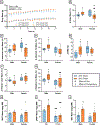HOUSING TEMPERATURE ALTERS BURN-INDUCED HYPERMETABOLISM IN MICE
- PMID: 39450911
- PMCID: PMC12173143
- DOI: 10.1097/SHK.0000000000002476
HOUSING TEMPERATURE ALTERS BURN-INDUCED HYPERMETABOLISM IN MICE
Abstract
Mice used in biomedical research are typically housed at ambient temperatures (22°C-24°C) below thermoneutrality (26°C-31°C). This chronic cold stress triggers a hypermetabolic response that may limit the utility of mice in modeling hypermetabolism in response to burns. To evaluate the effect of housing temperature on burn-induced hypermetabolism, mice were randomly assigned to receive sham, small, or large scald burns. Mice recovered for 21 days in metabolic phenotyping cages at 24°C or 30°C. Regardless of sex or sham/burn treatment, mice housed at 24°C had greater total energy expenditure ( P < 0.001), which was largely attributable to greater basal energy expenditure when compared to mice housed at 30°C ( P < 0.001). Thermoneutral housing (30°C) altered adipose tissue mass in a sex-dependent manner. Compared to sham and small burn groups, large burns resulted in greater water vapor loss, regardless of housing temperature ( P < 0.01). Compared to sham, large burns resulted in greater basal energy expenditure and total energy expenditure in mice housed at 24°C; however, this hypermetabolic response to large burns was blunted in female mice housed at 30°C, and absent in male mice housed at 30°C. Locomotion was significantly reduced in mice with large burns compared to sham and small burn groups, irrespective of sex or housing temperature ( P < 0.05). Housing at 30°C revealed sexual dimorphism in terms of the impact of burns on body mass and composition, where males with large burns displayed marked cachexia, whereas females did not. Collectively, this study demonstrates a sex-dependent role for housing temperature in influencing energetics and body composition in a rodent model of burn trauma.
Copyright © 2024 by the Shock Society.
Conflict of interest statement
The authors report no conflicts of interest.
Figures







References
-
- National Hospital Ambulatory Medical Care Survey: 2021 Emergency Department Summary Tables. Published online 2021.
MeSH terms
Grants and funding
LinkOut - more resources
Full Text Sources
Medical

